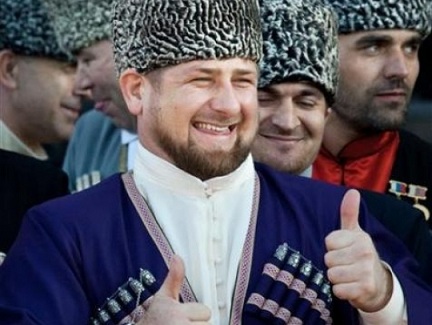Previous posts in this series: I, II, III.
*
 < Ramzan Kadyrov
< Ramzan Kadyrov
From Reuters:
Chechnya’s leader hails paintball attacks on women
The Kremlin-backed head of Russia’s Muslim Chechnya region has praised assailants who targeted women with paintball pellets for going bareheaded, prompting outrage on Thursday from rights activists.
Eyewitnesses have said men in camouflage, often worn by police and security forces in the volatile region, fired paintball guns from cars about a dozen times last month at women who were not wearing headscarves.
“I don’t know (who they are), but when I find them I shall announce my gratitude,” Ramzan Kadyrov said in a weekend interview on state-run regional television channel Grozny, according to a Reuters translation of the remarks in his native Chechen.
The attacks highlighted tension over Kadyrov’s efforts to enforce Muslim-inspired rules that in some cases violate Russia’s constitution.
Here’s a BBC version of the same story:
Since June, unidentified men with paintball guns have driven round the centre of Grozny shooting at women with uncovered heads. Leaflets were pinned on doors and scattered on the pavements which urged women to dress more modestly or face the consequences:
“Today we have sprayed you with paint, but this is only a warning!!! Don’t compel us to have recourse to more persuasive measures!”
On state television, Mr Kadyrov said he did not know who was responsible for the attacks, but added: “When I find them, I will express my gratitude.”
I’m interested in the various ways that (what might otherwise be called) a game can morph into war.
Clearly, a game can be training for warfare, as exemplified by Mao’s study of Go. It can serve, as did the Fisher-Spassky title match in Reykjavik, as a “continuation of war by other means”. In this case, in Chechnya, paintball appears to be functioning as a warning a shot across the bows, so to speak.
Are there other significant possibilities?
I pledge $10 to a brilliant charity I just dreamed up. We should raise the money to fly every tenured member of a womens’ studies department to Grozny to protest this abusive treatment of their Chechen sisters. Let’s see how their courageous opposition to the patriarchy does against the stone killers of the Caucasus. Oh, wait, it is only courageous to protest against people whom you know for sure won’t hurt you.
When did Larry the Cable Guy convert to Islam?
That right there’s funny, I don’t care who y’are.
Likeness!
*
Lex writes:
Irony aside, this is one of the big questions for Gandhi’s followers, isn’t it? “Non-violence may work against the Brits, who show some restraint – but what do you do when no quarter is given?”
Mark Shepard has a book titled “Mahatma Gandhi and his Myths” and an essay page of the same name on which he writes about the idea that “nonviolent action can work only against ‘easy’ enemies like the British, and not against, say, the Soviets, or Central American dictators, or those villains of last resort, the Nazis” and suggests the Solidarity movement in Poland and the overthrow of Ferdinand Marcos in the Philippines, and continues:
I ran across Gene Sharp briefly in the sixties, and am amused that he’s now known to Wikipedia readers as “the Machiavelli of nonviolence” and the “Clausewitz of nonviolent warfare”.
The trail that extends from Christ and St Francis via Thoreau and Gandhi to ML King and Gene Sharp is still fresh, still sparking new insights”¦